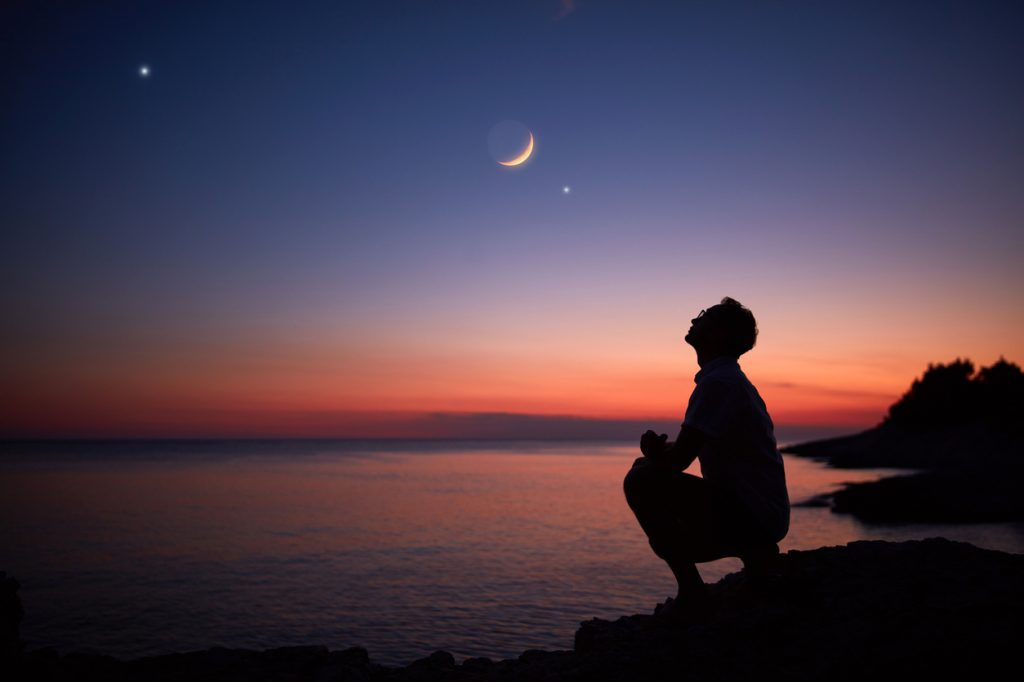A Special Planetary Eclipse Will Be Visible in the Sky This Week—Here’s How to Spot It

As our world’s view into the infinite reaches of space, the night sky essentially offers a non-stop lineup of memorable astronomical sights that are worth checking out. Stargazers have been treated to special events over the past few weeks alone as meteor showers and other easily spotted points of interest passed overhead. But this week, a relatively rare crossing will take place, making a special planetary eclipse visible in the sky. Read on for more information on the event and to learn how you can spot it for yourself.
READ THIS NEXT: 6 Stargazing Secrets, According to Astronomy Experts.
The moon will eclipse Jupiter in the sky later this week.

It’s hard to top a dramatic lunar or solar eclipse when it comes to astronomical events, but that’s not the only type of crossing that makes for a remarkable sight. In the early morning hours of May 17, the moon will eclipse Jupiter in a unique display, Forbes reports.
Fortunately, the sight is set to be particularly dazzling, given that the moon will only be at a slim six percent waning crescent phase. This reduces light in the night sky and helps optimizes any kind of stargazing, per Forbes.
During the event, viewers will see our satellite neighbor dance closely alongside our solar system’s largest planet before moving to block it from view. And while binoculars or a small telescope can enhance the experience, the spectacle will still be easily visible to the naked eye.
The special event won’t be visible again for over three years.

Similar to lunar and solar eclipses, the visibility of planetary eclipses is limited to some regions of the globe. But in this case, the spectacle will be on full display for stargazers in a wide range of places, including the eastern U.S. and Canada, parts of Mexico and Central America, much of the Caribbean, Greenland, Scandinavia, and the northern U.K., according to astronomy website In The Sky.
This week’s event is also similar in that this isn’t the kind of passing that happens very often. In fact, the next time the moon will eclipse Jupiter won’t be until late summer of 2026, per In The Sky. This makes it an essential sighting for anyone looking to cross it off their astronomical checklist.
RELATED: For more up-to-date information, sign up for our daily newsletter.
Here’s where to spot the special eclipse in the night sky.

Getting a glimpse of the planetary eclipse will undoubtedly be memorable, but it will also require getting up well before your alarm clock goes off. Jupiter will become visible just above the horizon in the early morning hours just before sunrise. To spot it, look to the east and try to locate the thin moon crescent, according to Forbes.
Depending on your location, you may be able to see Jupiter reemerge on the other side of the moon before dawn. However, since this will be in close position to the rising sign, it’s absolutely essential that you don’t point any telescopes or binoculars at the sunrise.
This week also has some of the best conditions for planning a night of stargazing.

Even if local weather conditions make viewing the eclipse impossible in your area, amateur astronomers might still want to clock off some time for stargazing this week. That’s because the moon will continue to thin down before it reaches its new phase on the night of Friday, May 19, making the night sky completely dark and primed for taking in plenty of planets and constellations, Forbes reports.
If you’re looking to get the most out of these pristine conditions, try getting to an area away from cities with as little light pollution as possible, according to NASA. You’ll also need at least 30 minutes of darkness for your eyes to adjust to conditions, which includes avoiding looking at your phone’s bright screen. Be sure to dress comfortably and bring a blanket or chair that makes it easy to lie back and look up at the sky.